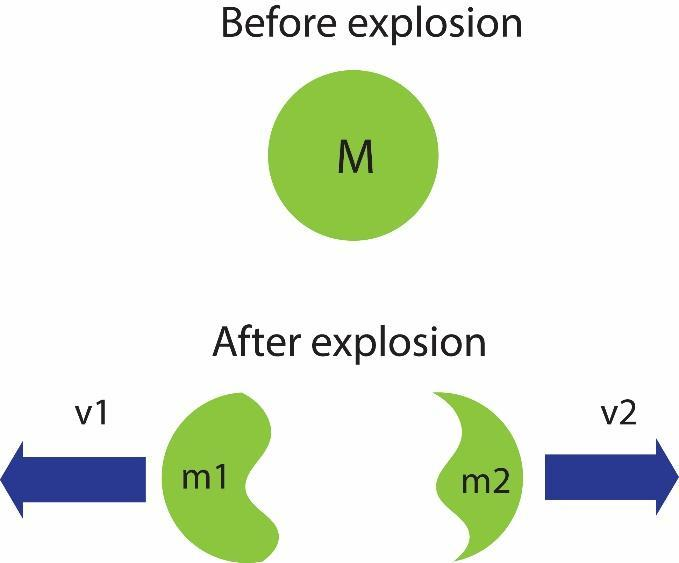
A stationary particle explodes into two particles of masses ${{m}_{1}}$ and ${{m}_{2}}$ which move in opposite direction with velocities ${{v}_{1}}$ and ${{v}_{2}}$. The ratio of the kinetic energies$\dfrac{{{E}_{1}}}{{{E}_{2}}}$ is
$\begin{align}
& \text{A}\text{. }\dfrac{{{m}_{1}}}{{{m}_{2}}} \\
& \text{B}\text{. 1} \\
& \text{C}\text{. }\dfrac{{{m}_{1}}{{v}_{2}}}{{{m}_{2}}{{v}_{1}}} \\
& \text{D}\text{. }\dfrac{{{m}_{2}}}{{{m}_{1}}} \\
\end{align}$
Answer
496.5k+ views
- Hint: First we will learn about Newton's third law. It states that for every action in nature there is an equal and opposite reaction. In other words, if object A exerts a force on object B, then object B also exerts an equal and opposite force on object A.
Complete step-by-step solution -
In the question it is given that the particle is stationary initially. Momentum of a particle is defined as the mass of the particle times its velocity. The particle’s initial velocity is 0. Hence, momentum will be zero. The explosion of the particle follows conservation of linear momentum principle. This states that, since no external force is acting on the particle, the momentum of the particle remains constant.

This means, after explosion, the total momentum is zero. The total momentum after explosion is given by,
$m_{1}{{v}_{1}}=m_{2}{{v}_{2}}$ . Here, the negative symbol is because the masses travel in opposite directions after the explosion. From, conservation of momentum, we can conclude that,
\[\begin{align}
& m _{1}{{v}_{1}}=m_{2}{{v}_{2}} \\
& \dfrac{{{m}_{1}}}{{{m}_{2}}}=\dfrac{{{v}_{2}}}{{{v}_{1}}}
\end{align}\] … (1)
The kinetic energy of a particle is defined by the energy that a particle contains due to its motion. The kinetic energy of a particle with mass m and velocity v is given by $\dfrac{1}{2}m{{v}^{2}}$.
The ratio of kinetic energies of masses ${{m}_{1}}$ and ${{m}_{2}}$,
\[\dfrac{{{E}_{1}}}{{{E}_{2}}}=\dfrac{\dfrac{1}{2}{{m}_{1}}{{v}_{1}}^{2}}{\dfrac{1}{2}{{m}_{2}}{{v}_{2}}^{2}}=\dfrac{{{m}_{1}}{{v}_{1}}}{{{m}_{2}}{{v}_{2}}}\dfrac{{{v}_{1}}}{{{v}_{2}}}=\dfrac{{{v}_{1}}}{{{v}_{2}}}=\dfrac{{{m}_{2}}}{{{m}_{1}}}\]
In the above equation, \[\dfrac{{{m}_{1}}{{v}_{1}}}{{{m}_{2}}{{v}_{2}}}=1\] from equation (1).
Thus, the correct answer is D.
Note: This problem is solved using conservation of momentum principle which is a modification of Newton's third law. This is the main principle used in sending rockets to space.
Complete step-by-step solution -
In the question it is given that the particle is stationary initially. Momentum of a particle is defined as the mass of the particle times its velocity. The particle’s initial velocity is 0. Hence, momentum will be zero. The explosion of the particle follows conservation of linear momentum principle. This states that, since no external force is acting on the particle, the momentum of the particle remains constant.

This means, after explosion, the total momentum is zero. The total momentum after explosion is given by,
$m_{1}{{v}_{1}}=m_{2}{{v}_{2}}$ . Here, the negative symbol is because the masses travel in opposite directions after the explosion. From, conservation of momentum, we can conclude that,
\[\begin{align}
& m _{1}{{v}_{1}}=m_{2}{{v}_{2}} \\
& \dfrac{{{m}_{1}}}{{{m}_{2}}}=\dfrac{{{v}_{2}}}{{{v}_{1}}}
\end{align}\] … (1)
The kinetic energy of a particle is defined by the energy that a particle contains due to its motion. The kinetic energy of a particle with mass m and velocity v is given by $\dfrac{1}{2}m{{v}^{2}}$.
The ratio of kinetic energies of masses ${{m}_{1}}$ and ${{m}_{2}}$,
\[\dfrac{{{E}_{1}}}{{{E}_{2}}}=\dfrac{\dfrac{1}{2}{{m}_{1}}{{v}_{1}}^{2}}{\dfrac{1}{2}{{m}_{2}}{{v}_{2}}^{2}}=\dfrac{{{m}_{1}}{{v}_{1}}}{{{m}_{2}}{{v}_{2}}}\dfrac{{{v}_{1}}}{{{v}_{2}}}=\dfrac{{{v}_{1}}}{{{v}_{2}}}=\dfrac{{{m}_{2}}}{{{m}_{1}}}\]
In the above equation, \[\dfrac{{{m}_{1}}{{v}_{1}}}{{{m}_{2}}{{v}_{2}}}=1\] from equation (1).
Thus, the correct answer is D.
Note: This problem is solved using conservation of momentum principle which is a modification of Newton's third law. This is the main principle used in sending rockets to space.
Recently Updated Pages
Master Class 11 Accountancy: Engaging Questions & Answers for Success

Glucose when reduced with HI and red Phosphorus gives class 11 chemistry CBSE

The highest possible oxidation states of Uranium and class 11 chemistry CBSE

Find the value of x if the mode of the following data class 11 maths CBSE

Which of the following can be used in the Friedel Crafts class 11 chemistry CBSE

A sphere of mass 40 kg is attracted by a second sphere class 11 physics CBSE

Trending doubts
Define least count of vernier callipers How do you class 11 physics CBSE

The combining capacity of an element is known as i class 11 chemistry CBSE

Proton was discovered by A Thomson B Rutherford C Chadwick class 11 chemistry CBSE

Find the image of the point 38 about the line x+3y class 11 maths CBSE

Can anyone list 10 advantages and disadvantages of friction

Distinguish between Mitosis and Meiosis class 11 biology CBSE




